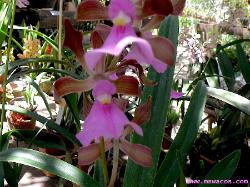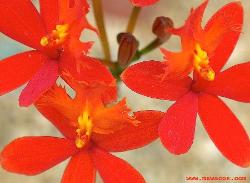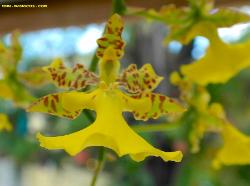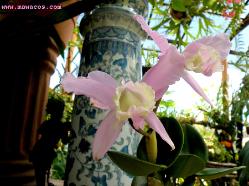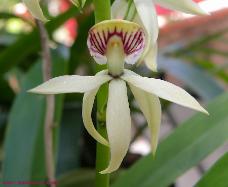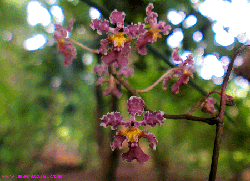| especies species |


| In other sections we have included plants native to other regions, because they have adapted and prosper in Mexico. This section only includes Mexican Orchids, because event though one commonly sees foreign species in nurseries, it is impossible for these to adapt to Mexico. As with our other collections, we invite you to help us grow it by sending us your photographs. And we appreciate any correction or suggestion. |
| En otras secciones hemos incluido plantas originarias de otras regiones, porque se han adaptado y prosperan en México. Esta sección solo incluye orquideas Mexicanas, porque aunque es común ver especies foráneas en viveros, es imposible que estas se adapten a nuestro pais. Al igual que con nuestras otras colecciones le invitamos a que nos ayude a ampliarla, enviandonos sus fotos. Y agradecemos cualquier corrección o sugerencia. |
| ||||||||||||||||||||||||||||||||||||||||||||||||||||||||||||||||||||||||||||||||||
ORQUIDEAS MEXICANAS
MEXICAN ORCHIDS
MEXICAN ORCHIDS
| Recomendamos estos libros sobre la Fauna de México. (Los nuestros son bilingues.) |
| To learn more about the Wildlife of Mexico, we recommend the following books. |
| A pesar de su reputación como exóticas y raras, la verdad es que las orquídeas representan una de las familias de seres vivos más exitosas del planetas. Hay más tipos de orquídeas que aves, mamíferos y reptiles. Se calcula que hay más de 25,000 especies y 100,000 variedades. Sin embargo, si son muy particulares. Las flores, famosas por ser tan coloridas y rebuscadas, están diseñadas para atraer a un animal polinizador en particular. En un caso famoso, Darwin predijo la existencia de una polilla con una lengua de 30 cm al ver una orquídea con un tubo de aproximadamente esa longitud. 100 años después, se confirmó la existencia de dicha polilla y su función como polinizador de esa flor. Otra característica general de las orquídeas es que son epífitas, es decir, que crecen sobre árboles sin parasitarlos. No dañan a su huésped de ninguna forma, ni se alimentan de el, simplemente lo utilizan como apoyo de donde agarrarse. Pero lo que realmente define que una orquídea sea una orquídea, es algo menos obvio: sus órganos sexuales masculino y femenino no están separados como en otras flores, sino que se encuentran fusionados en una sola estructura. En México encontramos más de 1,100 especies de orquídeas, el 40% de ellas endémicas. La más famosa de todas es la única orquídea de valor culinario, es decir la Vainilla - que para reproducirse debe ser polinizada el mismo día que florea, a diferencia de otras especies cuya flor puede durar meses. El género Laelia, que incluye 11 especies, se encuentra en estado natural únicamente en México y Centroamérica. Por lo menos una docena de orquídeas Mexicanas se encuentran en Peligro de Extinción, y muchas más están Amenazadas o sujetas a Protección Especial. El problema es uno de pérdida de hábitat. La destrucción de nuestros bosques pone en riesgo la supervivencia de muchas especies, y las más amenazadas son las más especializadas. Menos grave, pero aún importante, es el problema de la depredación y el tráfico ilegal, por lo cual se recomienda siempre comprar orquídeas de un vivero autorizado y jamás en la calle o el tiánguis. |
| Despite their reputation as exotic and rare, the truth is that orchids are one of the most successful families of living creatures on the planet. There are more types of orchids than birds, mammals and reptiles. There are an estimated 25,000 species, and 100,000 varieties. However, they are very particular. The flowers, famously colorful and complex, are designed to attract a specific pollinating animal. In one famed episode, Darwin predicted the existence of a moth with a foot-long tongue after seeing an orchid with a foot long tube. One hundred years later, such a moth was discovered and its role confirmed as the pollinator of that flower. Another general characteristic of orchids is that they are epiphytes, that is to say, they grow on trees without parasitizing them. They do not harm their host in any way, nor do they feed from it. They merely use it as a structure to grab onto. But what really makes an orchid an orchid, is something less obvious: their male and female sex organs are not separated as in other flowers, but rather fused into a single structure. In Mexico we have over 1,100 species of orchids, of which roughly 40% are endemic. The most famous is the only orchid with culinary value, Vanilla- which must be pollinated the same day it blooms, unlike other species whose flower can last for months. The genus Laelia includes 11 species which are only found naturally in Mexico and Central America. At least a dozen Mexican orchids are Endangered, and many more are Threatened or Subject to Special Protection. The problem is mainly habitat loss. Deforestation threatens many different species, and the most threatened are those most specialized. Less serious, but still worth mentioning, is the illegal harvesting and trafficking of orchids, which is why one should always purchase them from an authorized nursery, and never at a street market. |






